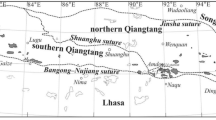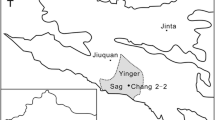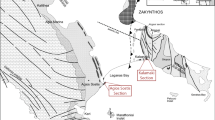Abstract
Continental organic-rich shales are well developed in the Dameigou Formation within the Yuka Depression of the Qaidam Basin. Here, the Rock-Eval pyrolysis, biomarkers, organic petrology, and stable carbon isotope have been carried out on the Middle Jurassic Dameigou Formation source rocks from the northwest part of Yuka Depression, Qaidam Basin in order to study their thermal maturity, source of organic matter (OM), and palaeoenvironment changes. The Rock-Eval pyrolysis data (e.g., Tmax), vitrinite reflectance, and biomarker-derived thermal maturity parameters (e.g., carbon preference index, Ts/(Ts+Tm), C29 Ts/(C29Ts+C29 αβ hopane), C30 αβ/(αβ+βα) hopanes, C29 ααα 20S/(20S+20R) steranes, and C29 αββ/(αββ+ααα) steranes) suggest all studied samples stay between immature and low mature stage. The maceral compositions, stable carbon isotope compositions, n-alkane distributions, and biomarker-derived source parameters (e.g., C27/C29 ααα 20R sterane, ternary diagram of C27-C28-C29 steranes, C24 tetracyclic terpane) indicate both aquatic organisms and higher plants are the source of OM in the shales, but land plants are dominant. Generally low gammacerane concentration and environment-related parameters (e.g., cross-plots of C27/C29 ααα 20R sterane vs. Pr/Ph) indicate these source rocks may be derived from lacustrine and fluvial-deltaic environments with fresh water, which is also supported by the variations of stable carbon isotopes from OM in the source rocks. However, the stable carbon isotope compositions of OM in the source rocks were influenced by multiple factors (e.g., source types and depositional environment) in the Yuka Depression. Slightly brackish condition is recorded in the upper part of the ZK6-1 well favor the formation of lacustrine algae, as confirmed by high contents of C27 steranes and short-chain n-alkanes. The variation of reducing to oxidizing condition of study area is possibly associated with the periodical flooded river-influenced aquatic condition during the deposition of the Middle Jurassic Dameigou Formation.
Similar content being viewed by others
References Cited
Alexander, R., Kagi, R., Noble, R., 1983. Identification of the Bicyclic Sesquiterpenes Drimane and Eudesmane in Petroleum. Journal of the Chemical Society, Chemical Communications, 5: 226. https://doi.org/10.1039/c39830000226
Algeo, T. J., Ingall, E., 2007. Sedimentary Corg: P Ratios, Paleocean Ventilation, and Phanerozoic Atmospheric \(p_{O_{2}}\). Palaeogeography, Palaeoclimatology, Palaeoecology, 256(3/4): 130–155. https://doi.org/10.1016/j.palaeo.2007.02.029
Algeo, T. J., Li, C., 2020. Redox Classification and Calibration of Redox Thresholds in Sedimentary Systems. Geochimica et Cosmochimica Acta, 287: 8–26. https://doi.org/10.1016/j.gca.2020.01.055
Bauer, P. E., Nelson, D. A., Watt, D. S., et al., 1985. Synthesis of Biological Markers in Fossil Fuels. 4. C27, C28, and C29 13.Beta., 17.alpha.(H)-Diasteranes. The Journal of Organic Chemistry, 50(26): 5460–5464. https://doi.org/10.1021/jo00350a003
Bechtel, A., Gratzer, R., Sachsenhofer, R. F., et al., 2008. Biomarker and Carbon Isotope Variation in Coal and Fossil Wood of Central Europe through the Cenozoic. Palaeogeography, Palaeoclimatology, Palaeoecology, 262(3/4): 166–175. https://doi.org/10.1016/j.palaeo.2008.03.005
Bechtel, A., Jia, J. L., Strobl, S. A. I., et al., 2012. Palaeoenvironmental Conditions during Deposition of the Upper Cretaceous Oil Shale Sequences in the Songliao Basin (NE China): Implications from Geochemical Analysis. Organic Geochemistry, 46: 76–95. https://doi.org/10.1016/j.orggeochem.2012.02.003
Bechtel, A., Oberauer, K., Kostić, A., et al., 2018. Depositional Environment and Hydrocarbon Source Potential of the Lower Miocene Oil Shale Deposit in the Aleksinac Basin (Serbia). Organic Geochemistry, 115: 93–112. https://doi.org/10.1016/j.orggeochem.2017.10.009
Berner, R. A., 1994. GEOCARB II; A Revised Model of Atmospheric CO2 over Phanerozoic Time. American Journal of Science, 294(1): 56–91. https://doi.org/10.2475/ajs.294.1.56
Berner, R. A., 2003. The Long-Term Carbon Cycle, Fossil Fuels and Atmospheric Composition. Nature, 426(6964): 323–326. https://doi.org/10.1038/nature02131
Bruce, W. S., Paul, J. V., 2008. Jurassic Climates. Proceedings of the Geologists Association, 119(1): 5–17
Cao, J., Bian, L. Z., Hu, K., et al., 2009. Benthic Macro Red Alga: A New Possible Bio-Precursor of Jurassic Mudstone Source Rocks in the Northern Qaidam Basin, Northwestern China. Science in China Series D: Earth Sciences, 52(5): 647–654. https://doi.org/10.1007/s11430-009-0063-6
Chattopadhyay, A., Dutta, S., 2014. Higher Plant Biomarker Signatures of Early Eocene Sediments of North Eastern India. Marine and Petroleum Geology, 57: 51–67. https://doi.org/10.1016/j.marpetgeo.2014.04.004
Chivelet, J. M., José, L. G., Aguado, R., et al., 2019. The Late Jurassic-Early Cretaceous Rifting, In: Quesada, C., Oliveira, J. T., eds., The Geology of Iberia: A Geodynamic Approach. Regional Geology Reviews. Springer Nature, Switzerland. https://doi.org/10.1007/978-3-030-11295-0_5
Chojnacka, K., Mikulewicz, M., 2018. Biomarkers of Trace Element Status. Recent Advances in Trace Elements. John Wiley & Sons, Chichester. https://doi.org/10.1002/9781119133780.ch22
Cloern, J. E., Canuel, E. A., Harris, D., 2002. Stable Carbon and Nitrogen Isotope Composition of Aquatic and Terrestrial Plants of the San Francisco Bay Estuarine System. Limnology and Oceanography, 47(3): 713–729. https://doi.org/10.4319/lo.2002.47.3.0713
Connan, J., Cassou, A. M., 1980. Properties of Gases and Petroleum Liquids Derived from Terrestrial Kerogen at Various Maturation Levels. Geochimica et Cosmochimica Acta, 44(1): 1–23. https://doi.org/10.1016/0016-7037(80)90173-8
Didyk, B. M., Simoneit, B. R. T., Brassell, S. C., et al., 1978. Organic Geochemical Indicators of Palaeoenvironmental Conditions of Sedimentation. Nature, 272(5650): 216–222. https://doi.org/10.1038/272216a0
Eglinton, G., Hamilton, R. J., 1967. Leaf Epicuticular Waxes. Science, 156(3780): 1322–1335. https://doi.org/10.1126/science.156.3780.1322
Escobar, M., Márquez, G., Inciarte, S., et al., 2011. The Organic Geochemistry of Oil Seeps from the Sierra de Perijá Eastern Foothills, Lake Maracaibo Basin, Venezuela. Organic Geochemistry, 42(7): 727–738. https://doi.org/10.1016/j.orggeochem.2011.06.005
Farrimond, P., Green, A., Williams, L., 2015. Petroleum Geochemistry of the Sea Lion Field, North Falkland Basin. Petroleum Geoscience, 21(2/3): 125–135. https://doi.org/10.1144/petgeo2014-052
Ficken, K. J., Li, B., Swain, D. L., et al., 2000. An n-Alkane Proxy for the Sedimentary Input of Submerged/Floating Freshwater Aquatic Macrophytes. Organic Geochemistry, 31(7/8): 745–749. https://doi.org/10.1016/s0146-6380(00)00081-4
Grantham, P. J., Douglas, A. G., 1980. The Nature and Origin of Sesquiterpenoids in some Tertiary Fossil Resins. Geochimica et Cosmochimica Acta, 44(11): 1801–1810. https://doi.org/10.1016/0016-7037(80)90229-x
Guo, T. X., Ren, S. M., Luo, X. R., et al., 2018. Accumulation Conditions and Prospective Areas of Shale Gas in the Middle Jurassic Dameigou Formation, Northern Qaidam Basin, Northwest China. Geological Journal, 53(6): 2944–2954. https://doi.org/10.1002/gj.3134
Hautevelle, Y., Michels, R., Malartre, F., et al., 2006. Vascular Plant Biomarkers as Proxies for Palaeoflora and Palaeoclimatic Changes at the Dogger/Malm Transition of the Paris Basin (France). Organic Geochemistry, 37(5): 610–625. https://doi.org/10.1016/j.orggeochem.2005.12.010
Hou, H. H., Shao, L. Y., Li, Y. H., et al., 2017. Geochemistry, Reservoir Characterization and Hydrocarbon Generation Potential of Lacustrine Shales: A Case of YQ-1 Well in the Yuqia Coalfield, Northern Qaidam Basin, NW China. Marine and Petroleum Geology, 88: 458–471. https://doi.org/10.1016/j.marpetgeo.2017.08.030
Jiang, L., Ding, W. J., George, S. C., 2020. Late Cretaceous-Paleogene Palaeoclimate Reconstruction of the Gippsland Basin, SE Australia. Palaeogeography, Palaeoclimatology, Palaeoecology, 556: 109885. https://doi.org/10.1016/j.palaeo.2020.109885
Jiang, L., George, S. C., 2018. Biomarker Signatures of Upper Cretaceous Latrobe Group Hydrocarbon Source Rocks, Gippsland Basin, Australia: Distribution and Palaeoenvironment Significance of Aliphatic Hydrocarbons. International Journal of Coal Geology, 196: 29–42. https://doi.org/10.1016/j.coal.2018.06.025
Jiao, G., Qin, J., **g, W., et al., 2005. Organic Petrology Characters of Jurassic Source Rocks in the Northern Margin of Qaidam Basin. Pet. Geol. Exp., 27(3): 249–250
Kodner, R. B., Pearson, A., Summons, R. E., et al., 2008. Sterols in Red and Green Algae: Quantification, Phylogeny, and Relevance for the Interpretation of Geologic Steranes. Geobiology, 6(4): 411–420. https://doi.org/10.1111/j.1472-4669.2008.00167.x
Lewan, M. D., 1983. Effects of Thermal Maturation on Stable Organic Carbon Isotopes as Determined by Hydrous Pyrolysis of Woodford Shale. Geochimica et Cosmochimica Acta, 47(8): 1471–1479. https://doi.org/10.1016/0016-7037(83)90306-x
Li, H., Ren, S., Guo, T., et al., 2016. Organic Geochemistry Characteristics and Reservoir Conditions of Jurassic Shale in Yuka Depression of Northern Qaidam Basin: A Case Study of Chaiye-1 Well. Geological Bulletin of China, 35(2/3): 250–259 (in Chinese with English Abstract)
Li, M., Shao, L. Y., Lu, J., et al., 2014. Sequence Stratigraphy and Paleogeography of the Middle Jurassic Coal Measures in the Yuqia Coalfield, Northern Qaidam Basin, Northwestern China. AAPG Bulletin, 98(12): 2531–2550. https://doi.org/10.1306/06041413129
Liu, B. J., Vrabec, M., Markič, M., et al., 2019. Reconstruction of Paleobotanical and Paleoenvironmental Changes in the Pliocene Velenje Basin, Slovenia, by Molecular and Stable Isotope Analysis of Lignites. International Journal of Coal Geology, 206: 31–45. https://doi.org/10.1016/j.coal.2019.03.006
Liu, S. M., Tang, S. H., Tan, F. R., et al., 2020. Pore Structure Characteristics and Hydrocarbon Generation Potential of Middle Jurassic Lacustrine Source Rocks in the Yuka Depression, Qaidam Basin, NW China: Implications from Petrographic and Organic Geochemical Analyses. Journal of Natural Gas Science and Engineering, 81: 103481. https://doi.org/10.1016/j.jngse.2020.103481
Liu, T., Shao, L., Cao, D., et al., 2013. Formation Conditions and Evaluation of Coal Resources of the Middle Jurassic in the Northern Qaidam Basin. Geological Press, Bei**g
Liu, Y. T., Hu, K., Cao, J. A., et al., 2008. Organic Biofacies of Jurassic Source Rocks in Northern Qaidam Basin, NW China. Petroleum Exploration and Development, 35(3): 281–288. https://doi.org/10.1016/s1876-3804(08)60073-7
Lu, J., Yang, M. F., Shao, L. Y., et al., 2016. Paleoclimate Change and Sedimentary Environment Evolution, Coal Accumulation: A Middle Jurassic Terrestrial. Journal of China Coal Society, 41(7): 1788–1797. (in Chinese with English Abstract)
Lu, J., Zhang, P. X., Dal Corso, J., et al., 2021. Volcanically Driven Lacustrine Ecosystem Changes during the Carnian Pluvial Episode (Late Triassic). Proceedings of the National Academy of Sciences of the United States of America, 118(40): e2109895118. https://doi.org/10.1073/pnas.2109895118
Lu, J., Zhang, P. X., Yang, M. F., et al., 2020a. Continental Records of Organic Carbon Isotopic Composition (δ13Corg), Weathering, Paleoclimate and Wildfire Linked to the End-Permian Mass Extinction. Chemical Geology, 558: 119764. https://doi.org/10.1016/j.chemgeo.2020.119764
Lu, J., Zhou, K., Yang, M. F., et al., 2020b. Terrestrial Organic Carbon Isotopic Composition (δ13Corg) and Environmental Perturbations Linked to Early Jurassic Volcanism: Evidence from the Qinghai-Tibet Plateau of China. Global and Planetary Change, 195: 103331. https://doi.org/10.1016/j.gloplacha.2020.103331
McKirdy, D. M., Cox, R. E., Volkman, J. K., et al., 1986. Botryococcane in a New Class of Australian Non-Marine Crude Oils. Nature, 320(6057): 57–59. https://doi.org/10.1038/320057a0
Meyers, P. A., 1994. Preservation of Elemental and Isotopic Source Identification of Sedimentary Organic Matter. Chemical Geology, 114(3/4): 289–302. https://doi.org/10.1016/0009-2541(94)90059-0
Milkov, A. V., Faiz, M., Etiope, G., 2020. Geochemistry of Shale Gases from around the World: Composition, Origins, Isotope Reversals and Rollovers, and Implications for the Exploration of Shale Plays. Organic Geochemistry, 143: 103997. https://doi.org/10.1016/j.orggeochem.2020.103997
Moldowan, J. M., Dahl, J., Huizinga, B. J., et al., 1994. The Molecular Fossil Record of Oleanane and Its Relation to Angiosperms. Science, 265(5173): 768–771. https://doi.org/10.1126/science.265.5173.768
Moldowan, J. M., Seifert, W. K., Gallegos, E. J., 1985. Relationship between Petroleum Composition and Depositional Environment of Petroleum Source Rocks. AAPG Bulletin, 69: 1255–1268. https://doi.org/10.1306/ad462bc8-16f7-11d7-8645000102c1865d
Mook, W. G., 2001. Environmental Isotopes in the Hydrological Cycle: Principles and Applications, v. II: Atmospheric Water. Contraception, 87(4): 506–507
Nott, C. J., **e, S. C., Avsejs, L. A., et al., 2000. n-Alkane Distributions in Ombrotrophic Mires as Indicators of Vegetation Change Related to Climatic Variation. Organic Geochemistry, 31(2/3): 231–235. https://doi.org/10.1016/S0146-6380(99)00153-9
Otto, A., Walther, H., Püttmann, W., 1997. Sesqui- and Diterpenoid Biomarkers Preserved in Taxodium-Rich Oligocene Oxbow Lake Clays, Weisselster Basin, Germany. Organic Geochemistry, 26(1/2): 105–115. https://doi.org/10.1016/S0146-6380(96)00133-7
Otto, A., Wilde, V., 2001. Sesqui-, Di-, and Triterpenoids as Chemosystematic Markers in Extant Conifers—A Review. The Botanical Review, 67(2): 141–238. https://doi.org/10.1007/bf02858076
Ourisson, G., Albrecht, P., Rohmer, M., 1979. The Hopanoids: Palaeochemistry and Biochemistry of a Group of Natural Products. Pure and Applied Chemistry, 51(4): 709–729. https://doi.org/10.1351/pac197951040709
Peters, K. E., Walters, C. C., Moldowan, J. M., 2005. The Biomarker Guide: Volume 2, Biomarkers and Isotopes in Petroleum Systems and Earth History. Cambridge University Press, Cambridge
Peters, K., Moldowan, J. M., 1993. The Biomarker Guide: Interpreting Molecular Fossils in Petroleum and Ancient Sediments. Prentice-Hall, Englewood Cliffs, NJ
Philippi, G. T., 1974. The Influence of Marine and Terrestrial Source Material on the Composition of Petroleum. Geochimica et Cosmochimica Acta, 38(6): 947–966. https://doi.org/10.1016/0016-7037(74)90067-2
Philp, R. P., 1985. Fossil Fuel Biomarkers: Application and Spectra. Elsevier Science and Publishing Company, New York
Qin, J., Wang, S. Q., Sanei, H., et al., 2018. Revelation of Organic Matter Sources and Sedimentary Environment Characteristics for Shale Gas Formation by Petrographic Analysis of Middle Jurassic Dameigou Formation, Northern Qaidam Basin, China. International Journal of Coal Geology, 195: 373–385. https://doi.org/10.1016/j.coal.2018.06.015
Regnery, J., Püttmann, W., Koutsodendris, A., et al., 2013. Comparison of the Paleoclimatic Significance of Higher Land Plant Biomarker Concentrations and Pollen Data: A Case Study of Lake Sediments from the Holsteinian Interglacial. Organic Geochemistry, 61: 73–84. https://doi.org/10.1016/j.orggeochem.2013.06.006
Ren, S. M., Bao, S. J., Zhang, Y., et al., 2016. Geological Conditions of the Jurassic Shale Gas on the Northern Margin of Qaidam Basin. Geological Bulletin of China, 35(2/3): 204–210 (in Chinese with English Abstract)
Ritts, B. D., Hanson, A. D., Zinniker, D., et al., 1999. Lower-Middle Jurassic Nonmarine Source Rocks and Petroleum Systems of the Northern Qaidam Basin, Northwest China. AAPG Bulletin, 83: 1980–2005. https://doi.org/10.1306/e4fd4661-1732-11d7-8645000102c1865d
Rohmer, M., Bisseret, P., Neunlist, S., 1992. The Hopanoids, Prokaryotic Triterpenoids and Precursors of Ubiquitous Molecular Fossils. In: Moldowan, J., Albrecht, P., Philip, R., Biol. Markers in Sediments and Pet., New Jersey, Prentice-Hall. 1–17
Sachsenhofer, R. F., Bechtel, A., Reischenbacher, D., et al., 2003. Evolution of Lacustrine Systems along the Miocene Mur-MÜRZ Fault System (Eastern Alps, Austria) and Implications on Source Rocks in Pull-Apart Basins. Marine and Petroleum Geology, 20(2): 83–110. https://doi.org/10.1016/s0264-8172(03)00018-7
Seifert, W. K., Moldowan, J. M., 1980. The Effect of Thermal Stress on Source-Rock Quality as Measured by Hopane Stereochemistry. Physics and Chemistry of the Earth, 12: 229–237. https://doi.org/10.1016/0079-1946(79)90107-1
Seifert, W. K., Moldowan, J., 1986. Use of Biological Markers in Petroleum Exploration. Biol. Markers Sediment. Rec., 24: 261–290
Shao, L. Y., Li, M., Li, Y. H., et al., 2014. Geological Characteristics and Controlling Factors of Shale Gas in the Jurassic of the Northern Qaidam Basin. Earth Science Frontiers, 21(4): 311–322 (in Chinese with English Abstract)
Shao, L.Y., Liu, L., Wen, H.J., et al., 2016. Characteristics and Influencing Factors of Nanopores in the Middle Jurassic Shimengou Shale in Well YQ-1 of the Northern Qaidam Basin. Earth Science Frontiers, 23(1): 164–173 (in Chinese with English Abstract)
Simoneit, B. R. T., 1985. Cyclic Terpenoids of the Geosphere. Methods Geochemistry Geophys, 25: 43–99
Sinninghe Damsté, J. S., Kenig, F., Koopmans, M. P., et al., 1995. Evidence for Gammacerane as an Indicator of Water Column Stratification. Geochimica et Cosmochimica Acta, 59(9): 1895–1900. https://doi.org/10.1016/0016-7037(95)00073-9
Stefanova, M., Kortenski, J., Zdravkov, A., et al., 2013. Paleoenvironmental Settings of the Sofia Lignite Basin: Insights from Coal Petrography and Molecular Indicators. International Journal of Coal Geology, 107: 45–61. https://doi.org/10.1016/j.coal.2012.09.014
Summons, R. E., Jahnke, L. L., Hope, J. M., et al., 1999. 2-Methylhopanoids as Biomarkers for Cyanobacterial Oxygenic Photosynthesis. Nature, 400(6744): 554–557. https://doi.org/10.1038/23005
Summons, R. E., Metzger, P., Largeau, C., et al., 2002. Polymethylsqualanes from Botryococcus Braunii in Lacustrine Sediments and Crude Oils. Organic Geochemistry, 33(2): 99–109. https://doi.org/10.1016/s0146-6380(01)00147-4
Ten Haven, H. L., de Leeuw, J. W., Rullkötter, J., et al., 1987. Restricted Utility of the Pristane/Phytane Ratio as a Palaeoenvironmental Indicator. Nature, 330(6149): 641–643. https://doi.org/10.1038/330641a0
Tissot, B., Welte, D., 1989. Petroleum Formation and Occurrence. Springer-Verlag, Berlin
Tong, X. N., Hu, J. F., **, D. P., et al., 2018. Depositional Environment of the Late Santonian Lacustrine Source Rocks in the Songliao Basin (NE China): Implications from Organic Geochemical Analyses. Organic Geochemistry, 124: 215–227. https://doi.org/10.1016/j.orggeochem.2018.07.018
Volkman, J. K., 1986. A Review of Sterol Markers for Marine and Terrigenous Organic Matter. Organic Geochemistry, 9(2): 83–99. https://doi.org/10.1016/0146-6380(86)90089-6
Wang, H. Y., Hou, Q. J., Sun, D. J., 2004. Mesozoic-Cenozoic Hydrocarbon Formation and Resource Assessment in the Northern Qaidam Basin. Science Press, Bei**g
Wang, L., Song, Z. G., Cao, X. X., et al., 2015. Compound-Specific Carbon Isotope Study on the Hydrocarbon Biomarkers in Lacustrine Source Rocks from Songliao Basin. Organic Geochemistry, 87: 68–77. https://doi.org/10.1016/j.orggeochem.2015.07.011
Wang, Y. D., Mosbrugger, V., Zhang, H., 2005. Early to Middle Jurassic Vegetation and Climatic Events in the Qaidam Basin, Northwest China. Palaeogeography, Palaeoclimatology, Palaeoecology, 224(1/2/3): 200–216. https://doi.org/10.1016/j.palaeo.2005.03.035
Wei, W., Algeo, T. J., 2020. Elemental Proxies for Paleosalinity Analysis of Ancient Shales and Mudrocks. Geochimica et Cosmochimica Acta, 287: 341–366. https://doi.org/10.1016/j.gca.2019.06.034
Weiss, H. M., Wilhelms, A., Mills, N., et al., 2000. NIGOGA-The Norwegian Industry Guide to Organic Geochemical Analyses [online]. Edition 4.0. Available at: http://www.npd.no/engelsk/nigoga/default.htm (accessed November 3, 2022)
Wierzbowski, H., Joachimski, M., 2007. Reconstruction of Late Bajocian-Bathonian Marine Palaeoenvironments Using Carbon and Oxygen Isotope Ratios of Calcareous Fossils from the Polish Jura Chain (Central Poland). Palaeogeography, Palaeoclimatology, Palaeoecology, 254(3/4): 523–540. https://doi.org/10.1016/j.palaeo.2007.07.010
Wood, D. A., Hazra, B., 2017. Characterization of Organic-Rich Shales for Petroleum Exploration & Exploitation: A Review-Part 3: Applied Geomechanics, Petrophysics and Reservoir Modeling. Journal of Earth Science, 28(5): 779–803. https://doi.org/10.1007/s12583-017-0734-8
Woodhouse, A. D., Oung, J. N., Philp, R. P., et al., 1992. Triterpanes and Ring-a Degraded Triterpanes as Biomarkers Characteristic of Tertiary Oils Derived from Predominantly Higher Plant Sources. Organic Geochemistry, 18(1): 23–31. https://doi.org/10.1016/0146-6380(92)90140-s
Yang, P., **e, Z. K., Yuan, X. J., et al., 2006. Palaeoecological Characteristics and Its Palaeogeographic Significance of the Jurassic in Northern Margin of Qaidam Basin. Journal of Palaeogeogrphy, 8(2): 165–173
Yuan, X. J., 2007. Evolution of the Jurassic Sedimentary Environment in Northern Margin of Qaidam Basin and Its Significance in Petroleum Geology. Pet. Explor. Dev., 34: 160–164
Yue, P., Wang, P., Yu, D., et al., 2011. Depositional Characteristics of the Early and Middle Jurassic on the Northern Margin of the Qaidam Basin and Their Implications for Petroleum Geology. Mar. Geol. Front., 27: 38–44
Zhong, X. C., Zhao C. B., Yang, S. Z., 2003. Northern Jurassic of Central China (II): Paleoenvironment and Petroleum. Petroleum Industry Press, Bei**g
Zou, C., Pan, S., **g, Z., et al., 2020. Shale Oil and Gas Revolution and Its Impact. Acta Pet. Sinica, 41(1): 1–12 (in Chinese with English Abstract)
Acknowledgments
This work was financially supported by the National Natural Science Foundation of China (Nos. 42102215, 41702144), and the Science and Technology Research Project for Higher Education Institutions in Hebei Province (No. QN2021033). The final publication is available at Springer via https://doi.org/10.1007/s12583-022-1617-1.
Author information
Authors and Affiliations
Corresponding author
Ethics declarations
The authors declare that they have no conflict of interest.
Rights and permissions
About this article
Cite this article
Liu, S., Jiang, L., Liu, B. et al. Investigation of Organic Matter Sources and Depositional Environment Changes for Terrestrial Shale Succession from the Yuka Depression: Implications from Organic Geochemistry and Petrological Analyses. J. Earth Sci. 34, 1577–1595 (2023). https://doi.org/10.1007/s12583-022-1617-1
Received:
Accepted:
Published:
Issue Date:
DOI: https://doi.org/10.1007/s12583-022-1617-1




